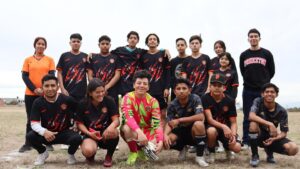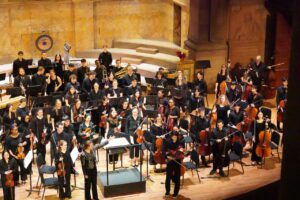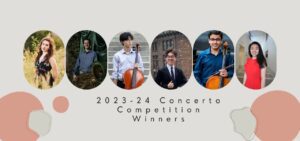Every November, thousands of music theorists and musicologists descend upon the vast ballrooms of America’s metropolitan convention hotels for their annual academic society meeting. This past November, the American Musicological Society (AMS), which celebrates its ninetieth annual meeting in 2024, and Society for Music Theory (SMT) held their joint conference in the Mile-High City of Denver, Colorado. It was by no means a rare occurrence: the AMS/SMT has been gathering on a biennial schedule since the year 2000, with the 2022 joint meeting of the AMS, SMT, and Society for Ethnomusicology (SEM) numbering upwards of 3,000 attendees! But it was a breath of fresh (albeit thin) air — a chance for music scholars, including a number of current and former Princetonians, to share research and ideas, spark conversation and collaboration, and forge critical connections over five frenetic, jam-packed days.
A highlight of the conference was a panel co-organized by Music graduate student Marcel Camprubi: Rethinking the West: Arabic and Hebrew Music Theory in Medieval Iberia. Awarded the prestigious AMS 50 dissertation fellowship in 2023 for his meticulous inquiries into the rich history of music in the Arabic Middle Ages, Camprubi was, according to fellow graduate student Elizabeth Rouget, something of a sensation: “Marcel’s panel was packed.” Presenting the first results of a new research project, Camprubi discussed twelfth-century music theorist al-Abdarī, who was born near Valencia but developed his career in Marrakesh, Morocco: “I shared my research on an Arabic manuscript currently in Leiden, the Netherlands, which contains one of just a handful extant music treatises from al-Andalus, the Muslim-ruled lands of the Iberian Peninsula in the Middle Ages. I identified the author of the treatise as al-Abdari [and] made the case to consider al-Andalus and the Maghreb, north-west Africa, as a cohesive music-theoretical space.”
The surge in interest in Camprubi’s (and his co-panelists’) subfield lends validity to a hypothesis long-held not only by Camprubi, but many scholars, including Anna Yu Wang, newly-appointed Assistant Professor — that translations may serve to revitalize and even birth areas of study beyond the Eurocentric norm. Yu Wang, who co-organized and chaired the session Redefining Music Theory through Translation, is gearing up for a larger project, dubbed “Music Theory in the Plural,” that will publish translations of music theoretical source documents from languages understudied in music academia and provide an online platform where people may discuss and annotate these materials collaboratively. “This is a long term project, but we wanted to bring it out into the public eye and to gain supporters in the field: we’re looking for commentators, people who can create more translations, and people who will be future users of the platform.”
In essence, “Music Theory in the Plural” is forging a space where scholars can both recognize and counteract what Yu Wang understands to be “the political ramifications of music theorizing.” Presenting a paper on polyphony and heterophony the following day, Yu Wang shared a salient example of how these terms, rather than denoting sonic or textural distinctions, are actually “more meaningfully expressive of sociopolitical difference: heterophony has often been used for music that is considered other, foreign, or culturally unfamiliar, while polyphony has been reserved for musics with a kind of prestigious social standing.”
The notion that the lens through which we view and discuss multicultural musics reinforces limiting and unjust perspectives — with, indeed, ramifications — is one that former Princeton Music graduate student and current music faculty member at Bowdoin Ireri Chávez-Bárcenas (*18) has long been placing at the center of her scholarship. Chávez-Bárcenas presented her paper “Listening to Black Voices in Early Modern New Spain.” In it, she explores the performance of villancicos — songs in the vernacular (Portuguese, Nahuatl, Spanish) that were part of the liturgy for Christmas and other major feast days — in the multilingual, multiracial city of Puebla in Mexico (where more enslaved Africans were sent than to the U.S.). “Anglophone scholars who insist on examining villancicos en habla de negro [the representation of African populations and their descendants in music, poetry, etc.] through the lenses of American minstrelsy have assumed that this genre has only served to reproduce racist essentialisms, which immediately imposes a limited perspective and prevents scholars and musicians from considering other possible readings.” Instead, Chávez-Bárcenas traces the sounds of Blackness in Gaspar Fernández’s villancicos by centering on the listening experience of free and enslaved Africans and their descendants living in New Spain to show how, amid labor reforms that aimed to better working conditions, the sometimes defiant messages of these songs, which urged that all had a right to celebrate the holiday, helped build community. Chávez-Bárcenas also participated in the panel “The Shape of Musicology to Come” organized by the Committee on Race, Indigeneity, and Ethnicity, where she shared her perspectives on critical race and identity in her research, teaching, and academic career.
Also looking at the global seventeenth century was Joyce Wei-Jo Chen, music faculty at the University of Oregon and final-year graduate student at Princeton. As were the detailed sketchbooks of Fernandez to Chávez-Bárcenas’ work, the meticulous manuscripts of sixteenth- and early seventeenth-century Chinese polymath (and Ming Dynasty prince) Zhu Zaiyu were instrumental in Chen’s conceptualizing of early modern dance studies — and of how those early practices can still be seen in Chinese opera today, a style Chen has studied alongside advisor Wendy Heller through the Peking Opera Program. While much of Chinese dance studies has relied on oral transmission, Chen found in Zhu’s texts remarkably detailed notes on the affect and implication of each dance move: “In Ming China, dance was an artistic, liturgical, and scientific manifestation of the human body. Under the Chinese ritual and music system (liyue), dance movements demarcate classes of people, symbolize seasons, and facilitate religious prayers.”
In the increasingly global society of the eighteenth century, as people crossed oceans and borders fleeing revolution, the music they brought with them took on a shapeshifting quality. Such was the context within which current graduate student Elizabeth Rouget situated her paper, “Opéra-Comique, Politics, and the French in Early America: Monsigny’s Le déserteur in Philadelphia.” Rouget was looking at a particular work of popular opéra-comique composer Pierre-Alexandre Monsigny (opéra-comique is a lighthearted, French operatic genre Rouget characterizes as “grand opera in miniature”). First brought to Saint-Domingue (modern-day Haiti) by a group of popular Paris stage performers looking to cash in on lucrative gigs in the colonies but who found themselves stuck due to revolutionary fervor back in Paris, Le déserteur traveled not long after to America as the Haitian Revolution caused the troupe to set sail again; landing in a post-American Revolution America, the troupe took part in the vibrant pockets of French culture, presenting Le déserteur, among hundreds of other works. Rouget shared, “In 18th century America, each city has a completely different political viewpoint on the Revolution. Revolutionary fervor in Philadelphia is much stronger than in Boston or New York, for example. Le déserteur shapeshifts in French, in English, and as a ballet in Philadelphia, because when you sing the final chorus of ‘God save the king’ in the 1790s, it becomes unclear which king is being referred to — George III? Louis XVI? George Washington, who wasn’t a monarch but was revered as one? I tell the story of the movement of people, music and dance, and traditions in a transatlantic context and how the works evolve in an ever changing North American political atmosphere.”
While for many Princetonians present at the AMS/SMT annual meeting, periods up to the eighteenth century formed their central scope of research, for Dylan Principi and Victoria Aschheim (PhD graduates under advisor Simon Morrison who are now visiting faculty at Wesleyan University and Carleton College, respectively) their research interests led them to the century preceding our own. Presenting in the New Perspectives on French Modernism session, Principi built on a presentation he gave to the Society of Music Theory in 2021 on composer Darius Milhaud’s strategies for creating dissonance in his string quartets. Composing in the years following the First World War, “Les Six,” a group of composers of whom Milhaud was a part, drove French musical identity forward. “The stakes were higher for Milhaud,” shared Principi, “who wanted to express his dual identity as both a Jewish person and a Frenchman through music. [Milhaud] devised his own means of creating dissonance by combining chords, melodies, and eventually whole works of music that are in disparate keys or tonalities, creating ‘polytonal’ juxtapositions. My presentation explored how fellow members of Les Six adapted Milhaud’s strategies for their own compositions, and how this made them the target of antisemitic criticism, which frequently masqueraded as the rejection of ‘ultramodernism.’” Aschheim presented a paper titled “Putting Ecstatic Minimalism into Words” as part of the session Style and Interpretation in American Music. In her paper, she unpacked the term “ecstatic” as it appears in reception of minimalist music from John Coltrane to Philip Glass to Julius Eastman: “Why does the word ‘ecstatic’ — and the prospect of an ecstatic minimalism — feel so right, so necessary? […] Referring to minimalist idioms as ‘ecstatic’ means drawing a conclusion and issuing an interpretive challenge all at once. I take up this challenge and limn the idea — the construction — of ‘ecstatic minimalism’ from the vantage of the twenty-first century.”
Given the “super fun mayhem” (as Rouget dubbed the event and others, chuckling, agreed) of the long weekend — with talks and interviews and panels and! — it was heartwarming to find that the consensus on favorite moment from the conference among all those interviewed was, across the board, getting to cheer on and catch up with Princeton colleagues old and new. “I once had a professor who said the best way to have a successful conference is to not go to too many papers. And it’s true,” Rouget shared. “You know, you’ve had a good conference when you’ve only gone to a handful because you’re so busy meeting everybody or catching up or working on projects and networking.”
(Other Princeton-affiliated presenters and participants included Christopher Parton, Louis Epstein, David Salkowski, Megan Sarno, Campbell Shiflett, Lucia Denk, Mauro Orsini Windholz, and Natalie Miller.)
In Other News
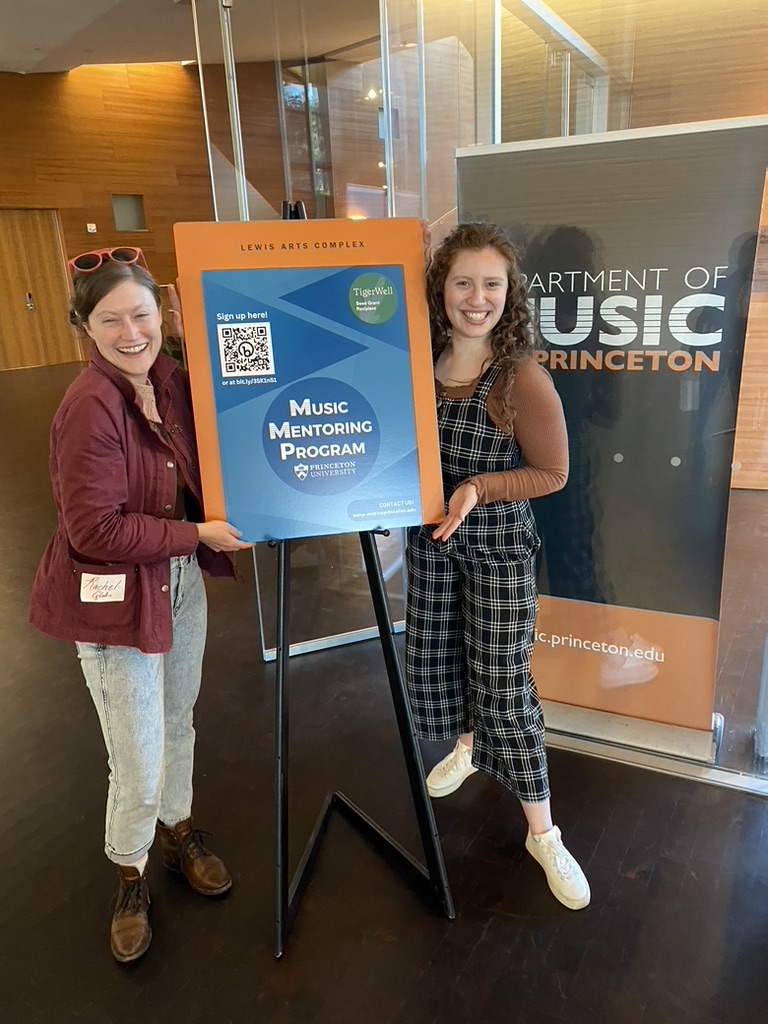
Get to Know the Music Mentoring Program
Sep 13, 2023
Learn about the Music Mentoring Program and join their welcome event on September 14 from 5:30PM-7:30PM in the Woolworth lobby

Graduate Student Marcel Camprubi Awarded Top Prize from the American Musicological Society
Jun 13, 2023
The Princeton University Department of Music is proud to congratulate graduate student Marcel Camprubi, who has been awarded the Alvin H. Johnson AMS 50 Dissertation Fellowship for his dissertation “Al-Fārābī’s Lines of Thought: Notations and Histories of Music Theory from Abbāsid Baghdad (762–1055).”
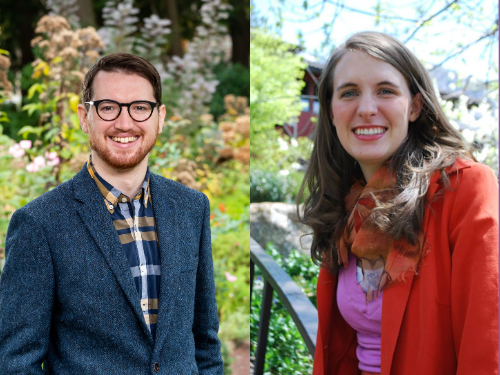
Musicology Graduate Students Christopher Parton & Hannah McLaughlin Receive 2023 Teaching Award
Apr 20, 2023
The Department of Music congratulates Musicology students Christopher Parton and Hannah McLaughlin, who were among the 10 winners of this year’s Graduate School Teaching Award in recognition of outstanding undergraduate teaching.


